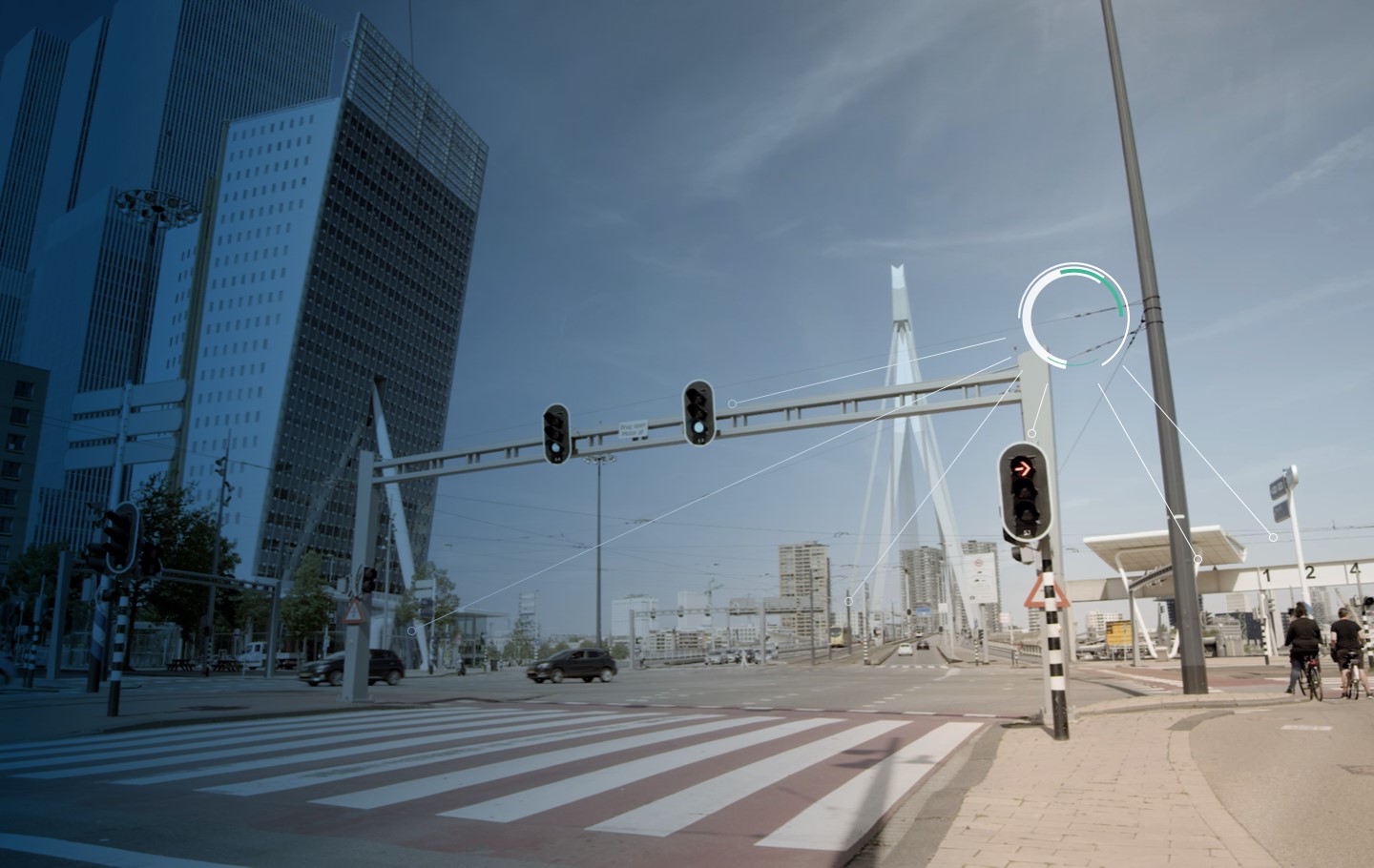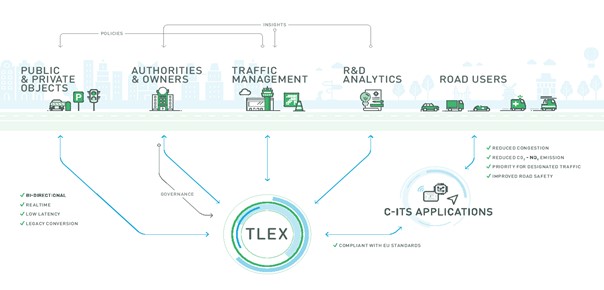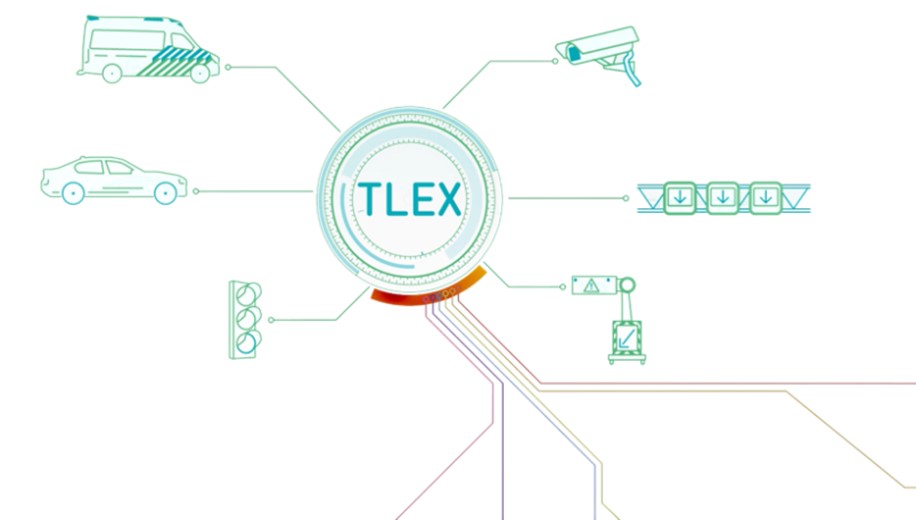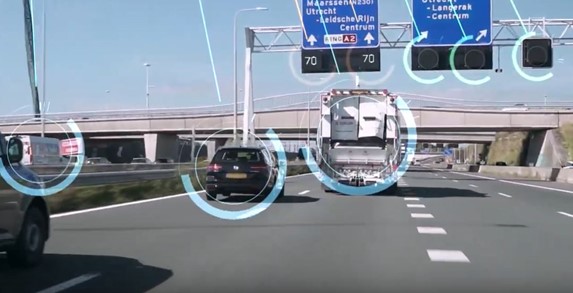
Many European countries are currently developing C-ITS ecosystems. An important aspect of this development is how data, as fuel for future mobility services, is being collected from the various links in the value chain and made available to service providers and other users. Dutch smart mobility platform company Monotch developed a game-changing neutral V2X platform, called TLEX. This vendor-independent platform can be used by multiple stakeholders. It has already proved itself in large-scale deployments in Europe.
Connected road users and infrastructure, sharing info, status and plans, continuously and in real time have enormous potential when it comes to improving safe, sustainable and efficient mobility. However, for solutions to be adopted by consumers massively, the gaps between data sources, transactions and services need to be bridged first. Colliding interests, lack of knowledge and protection of traditional business often prevent this and can block market progress.
Multi-stakeholder C-ITS ecosystems trending in Europe
Many European countries are currently developing C-ITS ecosystems. Examples of C-ITS implementation projects are the nationwide UDAP platform initiated by the Dutch Talking Traffic program, the NordicWay program with the Interchange platform, the Belgian MobiliData initiative, and EU projects such as InterCor, C-Roads, C-Mobile, and Concorda.
They bring together various public and private parties including road authorities, service providers, OEMs, traffic equipment vendors, and many more. One of the key factors to fully realise the potential of C-ITS and this burgeoning ecosystem is to build synergy and alignment between the different stakeholders. However, this requires cooperation from public and private entities, traditional competitors, as well as with new market entrants.
An important aspect of this development is how data is being collected from the various links in the value chain and made available to service providers and road users.

In a multi-vendor C-ITS ecosystem V2X platforms play a crucial role of connecting vehicles to the different roadside systems by facilitating the data exchange between various public and private systems in the ecosystem.
The need for a neutral V2X platform in a multi-vendor ecosystem
At the moment, many hardware suppliers include a V2X platform as part of their solution. However, in a multi-vendor C-ITS environment, competitors are often unwilling to interface their products to a competitor’s platform and vice versa, as they see such an open market approach hindering their efforts to protect market share and upsell road authorities their complete solution packages. Consequently, this also puts new entrants at a disadvantage as their products will most likely have to interface with traffic systems from larger technology equipment vendors and this lack of interfacing could serve as a barrier to enter the market. All this puts authorities procuring V2X platforms in a difficult position, because favouring one equipment vendor’s platform could result in a vendor lock-in for both hardware and software and adopting multiple platforms concurrently will be difficult to manage.
To maintain the open market nature of the C-ITS ecosystem and to ensure a level playing field for all parties to collectively develop the ecosystem, it is essential that this role remains independent and neutral.
Procuring V2X platforms from neutral and hardware-independent parties can resolve this issue. Unlike vendor specific ‘silo’ solutions the Dutch smart mobility platform company Monotch, developed a game-changing neutral V2X platform, called TLEX. A vendor independent platform which can be used by multiple stakeholders, it has already proved itself in large scale deployments in Europe. Monotch has assembled a neutral, open interface solution that supports the multi-vendor C-ITS eco-system including use-case tooling and KPI’s. The platform can handle both European ETSI protocols and proprietary protocols.
Current analysis in various EU projects shows that neutral V2X platforms such as TLEX are becoming the preferred design, especially in large-scale deployment scenarios.
From research to C-ITS deployment to full connected services
A few years ago Dutch ITS specialists from Monotch started to develop a neutral V2X multi-stakeholder platform called TLEX in order to connect data, transactions and services in the mobility ecosystem. In the Netherlands they connect all intelligent TLCs to the TLEX platform and are able to reliably exchange TLC data and vehicle travel data.

As Menno Malta, CEO of Monotch, explains, TLEX not only connects large amounts of low latency data streams while taking the formats, data model, and integrity into account but it also facilitates the quality assurance, security, administrative functions. The platform continuously checks for data consistency and rejects invalid data, for instance time synchronization and latency.
“In 2020 we also added useful functions to TLEX," says Malta. "These Included quality control, quality monitoring, and links to other objects besides iTLCs like barriers, mobile road signs, inspection and maintenance vehicles, bollards and sensors, and a function to define the policy rules for vehicle priority. And for road operators, TLEX also offers extensive monitoring and reporting functionalities with information about the status and data flows of the connected roadside systems.”
Notable characteristics and benefits
The TLEX-platform is an example of a highly scalable system which is specifically designed to send and receive massive volumes of data with ultra-low latency. Of course, secured and privacy safeguarded (iso27001 and GDPR compliant). The data exchange is bi-directional and continuously available in real-time. The ready-to-use technology with available interfacing and many protocol options is suitable for small projects as well as for large scale deployments and free for C-ITS Proof of Concepts. The ‘Software as a Service’-platform is especially developed for cities and road authorities who are dissatisfied with rigid project-oriented solutions.
It is clear that the deployment of ITS systems and data exchange via V2X platforms provides many benefits for the stakeholders in the C-ITS ecosystem. Firstly, road authorities are able to retain control of public data, improve traffic flows and road safety. They have also gained an important policy instrument to prioritize certain road users, and implement and analyze traffic policies based on detailed real time traffic data without implementing expensive road side communication systems.
V2X platforms are often used for ‘prioritizing services’ whereby freight traffic, emergency services, public transport and cyclists can be given priority over other traffic at traffic lights. And they are used to optimize traffic flows. But more importantly they are used to inform road users in real-time. Data from smart traffic light controllers, for instance, can be used to inform drivers about the time-to-green.

International roll-out of the TLEX data exchange platform
Monotch is supplier of the Dutch Urban Data Access Platform (UDAP). This nationwide C-ITS platform receives data from roadside systems like intelligent traffic control systems, barriers, bollards and sensors and automatically sends this to the road authorities. Conversely, UDAP also receives (anonymised) travel and vehicle-related data from road users. In addition to the use of its TLEX V2X software platform for UDAP, Monotch also monitors the quality, security, and privacy of the data exchange.
The TLEX platform is also used in Scandinavia in NordicWay, where Monotch’s role is to further develop the Swedish interchange network. According to Monotch International Business Developer Gary Lin, the company's main objective for NordicWay is to enhance its TLEX platform by incorporating new functionalities, payloads, and interfaces. "We are doing this by sharing experiences from C-ITS deployments in the Netherlands and incorporating C-Roads standards to the TLEX platform and implementing it under new specifications and architectural set-ups that differ from previous deployments. In July 2021 Monotch plans to go live with the Swedish interchange and will also provide local C-ITS data exchange services.”
The Flemish MobiliData initiative has also adopted this solution and has started a procurement based on the Dutch and NordicWay experiences.
Countless policy instruments and new use cases
Most prominent TLEX V2X use cases are informing traffic users in real time, improving traffic flows and giving priority for designated traffic. But the data exchange via the platform can also be used to warn about hazardous locations, to grant access to emergency services, or to provide access control in city areas and enforcement purposes such as red-light violation. As the TLEX platform evolves, new use cases will be devised. A variety of different sensors will be integrated, including measuring tyre pressure, monitoring height clearance and cycling radar.
Thanks to a TLEX link to advanced cycling radar and smart traffic control systems, cyclists in Utrecht can now ride faster and safer through green lights. In the case of approaching bicycle pelotons, the traffic light can therefore switch to green sooner or remain green for longer. The more vehicles are detected on the cycle path, the more priority the traffic light can give. In the future, bicycle radar units will be linked to intelligent TLCs at many more locations in the Netherlands so that road managers can better anticipate traffic situations.
Partnerships
Menno Malta points out that the TLEX data cloud provides a digital backbone for new connected (traffic) services and use cases are actually countless: “So no need to go or stay national, for the TLEX platform has been successfully tested in Trondheim and Copenhagen and will provide local C-ITS data exchange services for the hybrid initiative in Gothenburg and the In-vehicle Signage Proof of Concept for NordicWay3. The TLEX platform can also easily be applied in small local projects to improve traffic flow or give priority to specific road users.”
In order to speed up further C-ITS rollout across Europe, Monotch is currently looking for more partnerships and to join forces with technology vendors or solution providers. Menno Malta confirms that this is a great way to connect Monotch expertise and technology. “Further European cooperation clearly shows that ecosystem solutions are the basis for improving the mobility system,” he says.
Sponsored content produced in association with Monotch











